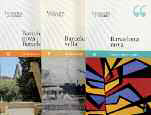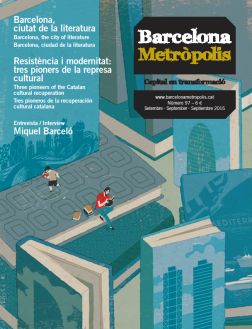 Barcelona nova, Barcelona vella, Barcelona nova i el Barcelonès
Barcelona nova, Barcelona vella, Barcelona nova i el Barcelonès
- Volumes 8 (336 pages), 9 (284 pages) and 10 (306 pages) of the “Geografia Literària” collection
- Editorial Pòrtic and Barcelona City Council, 2013-2015
Weighing 1.5 kg, with 900 pages, nearly 20,000 bibliographical references and 150 personal thank-yous from the author – these are the stripped-back overall figures for the three latest volumes in the “Geografia Literària” collection from the publisher Editorial Pòrtic, by teacher and philologist Llorenç Soldevila i Balart.
There are nearly 800 domestic tourism proposals for local travellers via buildings and places that are (in)directly linked to intellectual Barcelona, all of which are efficiently organised into three large geographical areas, outlined by literature professor Joaquim Molas in the prologue to volume 10: the “old” Barcelona, within the city walls; the Barcelona of the small historical towns that make up the surrounding area; and the “new” Barcelona of the Eixample district. Three cities “that coexist while each preserving their own identity” and each of which also show three levels of reality, which are in turn highlighted by journalist Lluís Permanyer, author of the prologue to volume 9: “That of the urban landscape, the one that exists and that we can say constitutes the point of reference and the source of everything”; “the one formed by more or less academic texts, in which the data […] shape the basis of the information”; and “the literary image […] that provides us with emotional values, regardless of the creative depth they may offer”.
These six great coordinates direct Soldevila’s guides, which Molas describes as “grand literary geography”, and Permanyer calls an “anthology with strict geographical limits”. Every “literary place” mentioned is perfectly defined through visual photography and a textual description, as well as a sensorial quotation in the form of a biographical text, poem, ode, song or paragraph of fiction.
Do not, therefore, expect a guide that consists of recommendations of use, but instead a selection of enjoyable spots – from writers’ birthplaces or childhood homes to the sculptures and monuments that are scattered throughout the city, as well as the squares and streets dedicated to men and women of letters and numerous spaces that recall the authors of today, yesterday and even earlier. Moreover, for every location, it has been possible to find “the right text to underscore it”, “with great intellect and sensitivity”, according to Molas.
One example is an unpublished work by Molas himself, about the flat and neighbourhood in the Eixample district where he lived for more than 40 years. Or Quim Monzó’s description from the balcony of Carrer de Floridablanca leading onto Paral·lel. And a song poem by Ovidi Montllor, surely conceived in his last house in the La Salut neighbourhood. The guides also feature bars and cocktail bars, lifelong establishments, schools and dozens of authors’ graves, as well as the beasts at the zoo…and the beasts at the Jefatura de Policía. It even goes down to the bar at the University, “a space of freedom […] where Montserrat Roig wrote one of her first stories”; suggests readings by Carme Riera, Baltasar Porcel and Màrius Sampere when we reach the entrances to the underground stations at Urquinaona, Vall d’Hebron and Santa Coloma; roams the corridors of Hospital Clínic, and takes us to Parc del Clot, where it suggests another surprise (can you guess?) by Miquel Desclot.
Soldevila’s prolific literary route condenses hundreds of landscapes with passages inspired by Barcelonas that are not only richly described and written, but also timeless.



